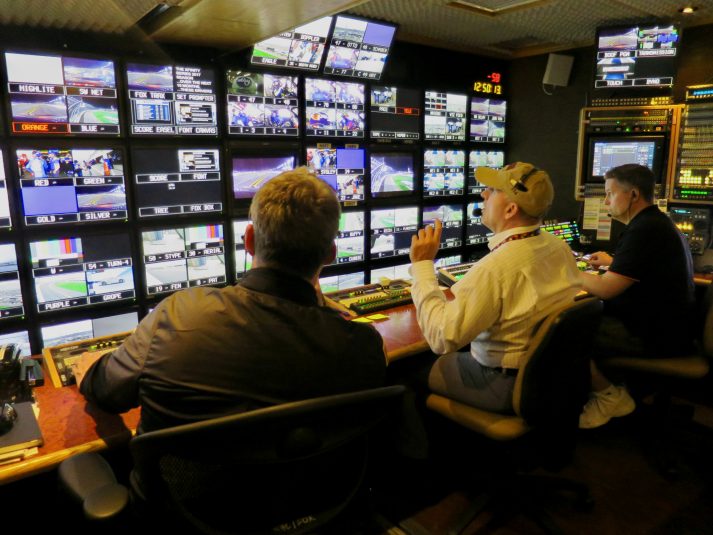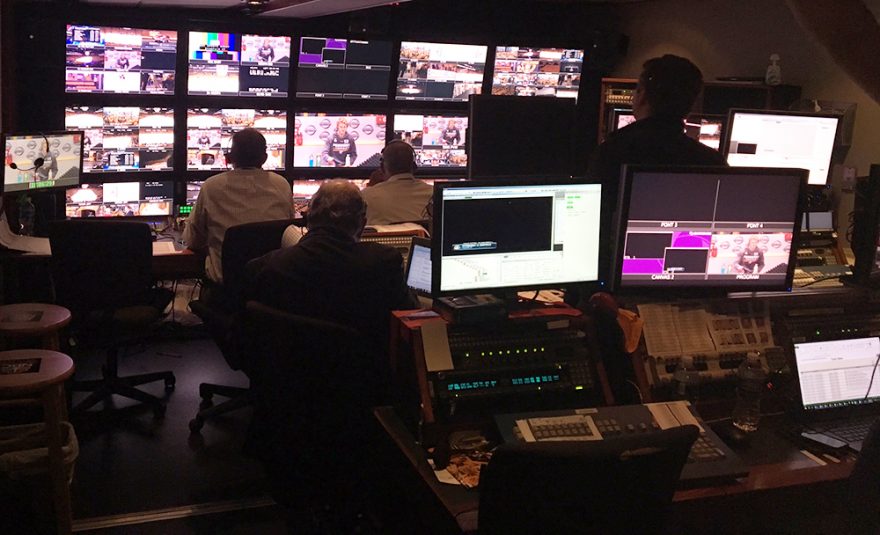Road Warriors 2017: The Top Remote Production Highlights of the Year
In this year in review, SVG takes a look at some of the biggest events on the annual sports-production calendar.
Story Highlights
2017 was an eventful year for sports production, with marquee events like the College Football Playoff National Championship Game, Super Bowl, and NBA and MLB All-Star Games test-driving new technologies and production workflows and annual tournaments like NCAA’s March Madness, U.S. Open golf, and US Open tennis using the best tools that sports broadcasting has to offer to spotlight the best in their respective sports. Add in the FIFA Confederations Cup in Moscow as well as the Daytona 500, Stanley Cup Final, and X Games Minneapolis — not to mention, a wide range of European sports productions — and 2017 certainly shaped up as quite the year for the live sports production. And, with the 2018 Winter Olympics and FIFA World Cup on the horizon, it’s only the beginning. Here’s a look at some of the highlights from the past year.
College Football Playoff National Championship Game
Raymond James Stadium, Tampa, FL
January 9
The College Football Playoff National Championship Game is the first truly big day on the sports-production calendar, and ESPN again treated the game like the crown jewel that it is, with a production stunning in both scope and scale.
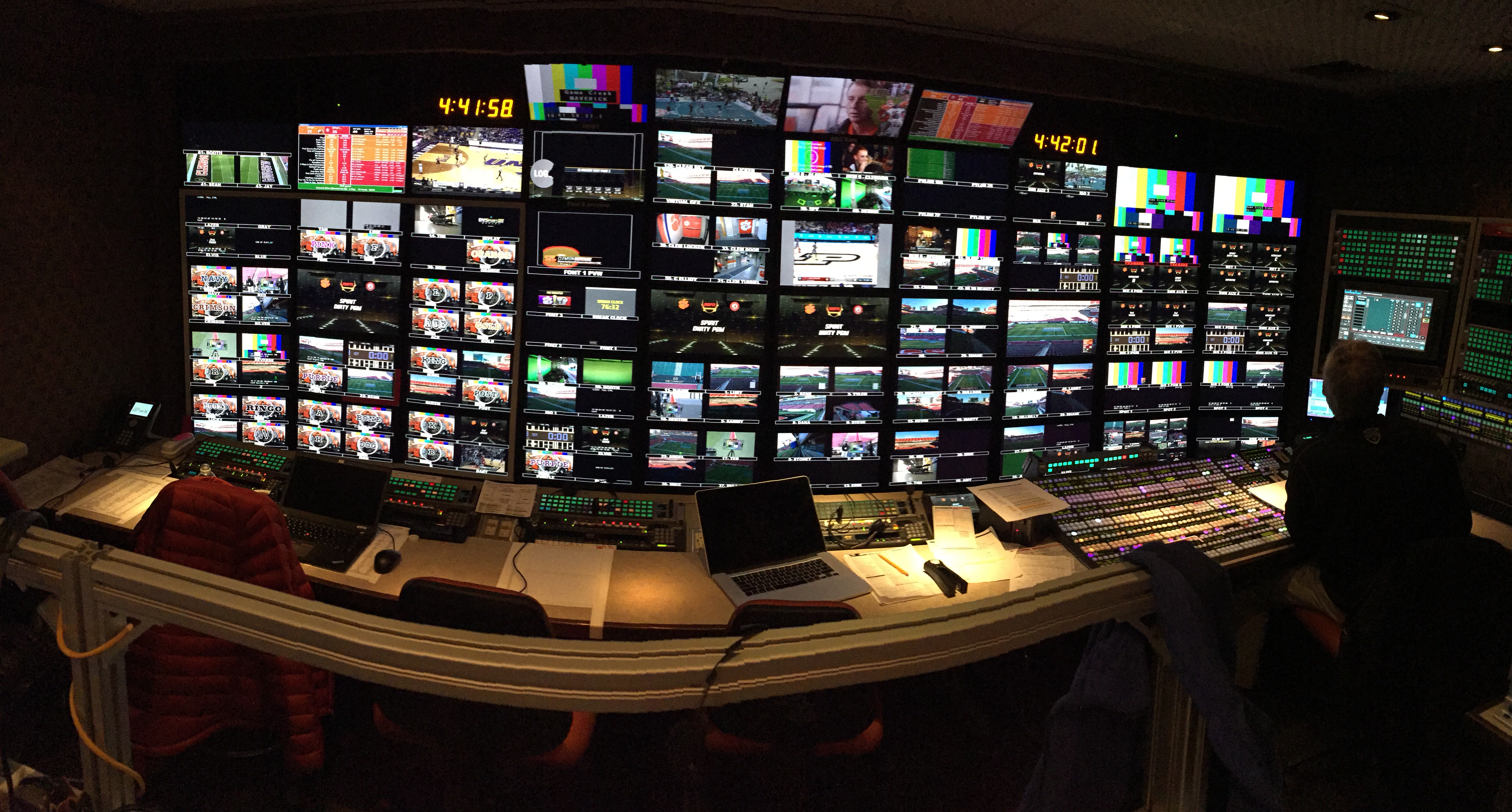
Inside Game Creek Video’s Spirit, home to the main game production of the CFP National Championship on ESPN
There were 111 cameras inside the stadium supporting the network’s efforts in producing the main game telecast, the 13 additional MegaCast options, and three studio sets around the building. Ninety-five of those cameras were pointed at the game between Clemson and Alabama (the Tigers defeated the Crimson Tide 35-31), with nine super-slow-motion cameras and five 4K-capable cameras accompanying.
Pylon cameras were on the four corners of each end zone, and cameras were strategically placed to capture each important boundary from the sidelines to the goal lines. “We’ve got every line covered,” said Ed Placey, senior coordinating producer, ESPN, prior to the game. “We just hope we have a great game where we can show it all off.”
Among the camera highlights was a collection of Sony’s HDC-4800’s, which debuted at the 2016 NAB Show. The camera is capable of 8X super-slo-mo in 4K and 16X when shooting in HD. A few Canon DIGISUPER 95 telephoto lenses were deployed on some of the cameras at valuable positions.
Standing outside Game Creek Video’s Spirit prior to kickoff, ESPN Director, Remote Operations, John LaChance struggled to find the adjectives to describe the sheer magnitude of the event. “It’s mammoth,” he said, indicating the sprawling compound sitting in the shadows of Raymond James Stadium.
In addition, Clemson’s video production team of 10 flooded various channels via an array of video-production tools in advance of the big game. — Brandon Costa
CLICK HERE for full coverage of the CFP National Championship Game.
Super Bowl LI
NRG Stadium, Houston
February 5
At Super Bowl LI, Fox Sports introduced several technical innovations that will not fade from memory any time soon. “It’s a showcase, a stage,” noted Mike Davies, SVP, technical and field operations, Fox Sports, “and, the way technology is going, it will always feature some new things.”
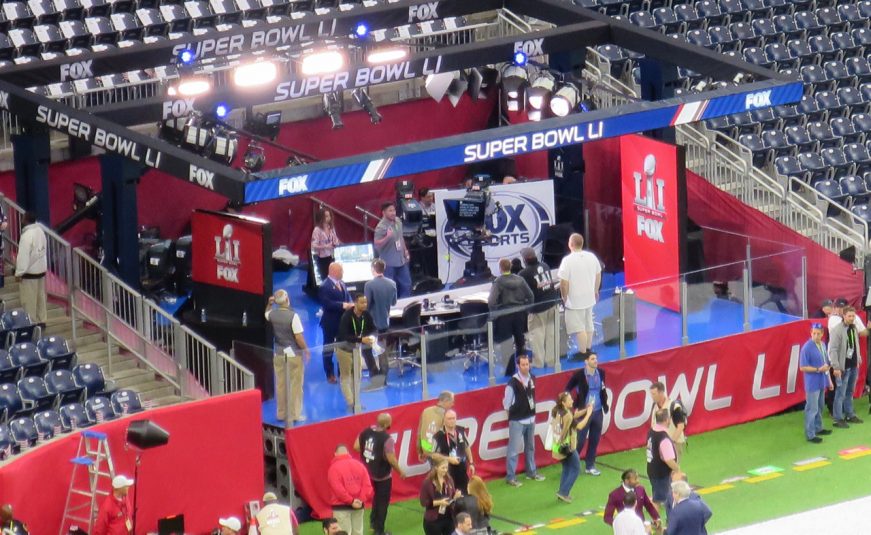
The Fox Sports pre-game set was nestled into the corner of NRG Stadium behind the Patriots end zone.
The technical advance that had the biggest impact on the production was the use of more super-slo-mo systems and high-resolution cameras than had ever been used at a Super Bowl. Sony HDC-4300 and P43 cameras were operating in 4K mode in key locations — goal line, end line, sidelines — so that the production team could zoom in for high-resolution close-ups. And two Sony HDC-4800 cameras were on hand for super-slo-mo coverage.
Fox Sports also took pylon cameras to the next level with a simple change: the cameras were angled at 45 degrees rather than perpendicular to the lines. “What we like about it is that you can see more of the field. We can potentially do a replay that goes from one camera in the pylon to the next,” said Davies. “And, now that the cameras are HD, it’s shocking how good they are.”
Game Creek Video’s Encore production unit made its Super Bowl debut, and Cleatus, which is normally deployed by another network under a different name, was used for pregame coverage. Also on hand at the stadium was Game Creek’s Chesapeake, which was used for the red-carpet show.
NEP, meanwhile, handled Fox production needs at Discovery Green with ND1 on hand for the full week of programming. The shows were cut in the ND1 unit and delivered to Pico, Fox’s Los Angeles facility, for graphics insertion. — Ken Kerschbaumer
CLICK HERE for full coverage of Super Bowl LI.
NBA All-Star Game
Smoothie King Center, New Orleans
February 19
New Orleans hosted the NBA All-Star Weekend only three years after hosting the 2014 festivities. Typically, when a sports event returns to the same city that quickly, the production philosophy remains the same. That was not the case for Turner Sports.
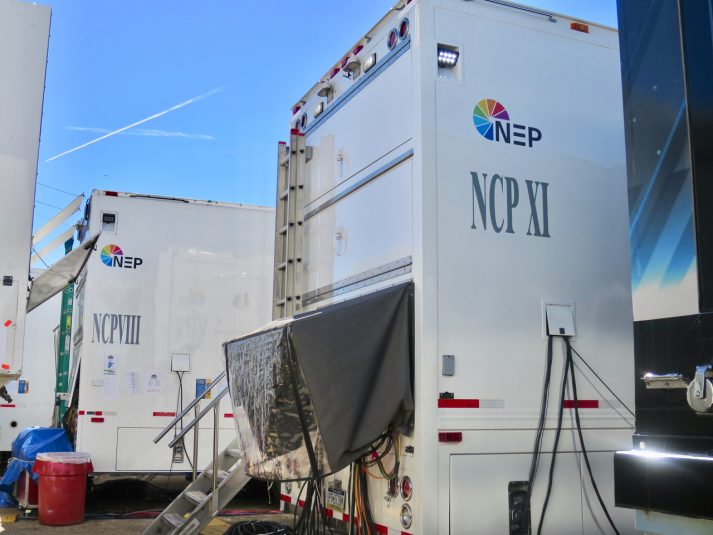
NEP had a big presence in the Big Easy in support of Turner Sports.
“This is a very different show than it was three years ago,” said Chris Brown, senior director, technical operations, Turner Sports. “The big difference is the deliverables and a compelling basketball game that uses as much technology as we can cram.”
Among the biggest changes? Turner’s NBA on TNT road show, a 70,000-sq.-ft. fan-activation effort that includes a set for the Inside the NBA studio show, concerts, the final of the Dew NBA 3X three-on-three tournament, interactive fan experiences, basketball clinics, and pop-up stores. It was located at Champions Square, about 1,500 ft. from the Smoothie King Center, which hosted the Rising Stars Challenge on Friday, All-Star Saturday Night on Saturday, and the All-Star Game on Sunday.
NEP played a big role in Turner’s production of the weekend’s activities with SS24 at the center of the game coverage, NCP10 for All-Star Saturday night, NCP 11 for the studio show, NCP8 for the entertainment and halftime elements, and ND1 for transmission and more. The use of ND1 continued to evolve at the All-Star Game.
Turner put 58 cameras to use inside the Smoothie King Center for both the on-the-court and TNT studio coverage (the world-feed production also had unilateral cameras because the game was seen in 215 countries and territories and in 49 languages). One exciting new production tool was addition of a Spidercam for coverage of the All-Star Saturday Night activities: the slam-dunk contest, three-point shooting contest, and skills challenge. It was also the first time a cabled camera flew over the court during on-court action.
Aside from the linear telecast, Turner Sports had more than a dozen people working specifically on social-media executions. In addition, an army of vendors were on hand to support the production, including Bexel (which debuted the Clarity 800 slo-mo camera), Broadcast Services International, CTG, Shure,
— KK
Daytona 500
Daytona International Speedway, Daytona Beach, FL
February 26
The Super Bowl of motorsports, the Daytona 500 shifted into high gear on Fox Sports. Among returning technology favorites was Gophercam (for its ninth season), and there were also some new elements: two dedicated Car Channels on the Fox Sports GO app, a “playbook” for the 3D-cutaway car that helped NASCAR analyst Larry McReynolds get analysis on-air more quickly, more high-speed cameras (two high-frame-rate 4K Sony HDC-4800 cameras for super zoom, four super-slo-mo HD units, two Inertia Unlimited X-Mos), and eight in-car camera packages.
“Daytona is the first race, and we want to put resources into it to begin with,” said Mike Davies, SVP, technical and field operations, Fox Sports. “It’s helpful that we are here for two weeks as we can test things and see what sticks for the season.’
Overall, Fox deployed 20 manned cameras along with the previously mentioned in-track, in-car, and high-speed cameras. Also used were 10 robotic cameras mounted around the track, three robotic cameras at the Hollywood Hotel studio set, a jib camera with augmented reality, four RF roving pit/garage cameras, two in-car gyro-cams, and more than 150 microphones.
Game Creek Video was once again on hand for Fox Sports at the Daytona 500, and 2017 marked the 11th straight event with the FX production unit at the center of the Fox operation. The Game Creek presence at the race comprised FX A, B, and D units; Edit 1 and 2; and a Robo trailer. The two Edit units and the Robo were deployed for the Super Bowl and made the trip to Daytona directly from Houston. — KK
CLICK HERE for full coverage from Daytona.
NCAA Men’s Basketball Final Four
University of Phoenix Stadium, Glendale, AZ
April 1 – 3
The collaborative effort of CBS Sports and Turner Sports continued with the operations and engineering at this year’s Final Four, but it was an “all-CBS” year, and long-time CBS Sports star Patty Power took the helm, overseeing the production compound.
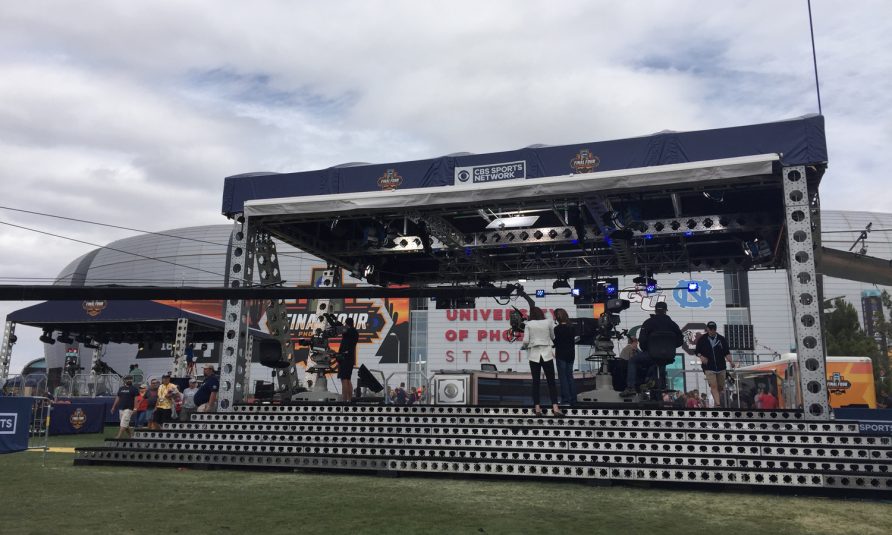
Turner and CBS erected two sets on the “Great Lawn” outside University of Phoenix Stadium.
“It’s been really great,” said Power, who is EVP, operations and engineering. “There are so many good people in place that have been here doing this for so long. Where I’m coming from is trying to find ways to do things more effectively. I want us to be smart about it. There are little tweaks here and there and those ideas I get to implement now.”
A total of 50 cameras were inside the University of Phoenix Stadium bowl, covering both game action and a studio set located in the student section behind one of the baskets. There was a collection of 4K cameras on the backboards. Nine Sony HDC-4300’s were in various positions shooting at 8X super-slow-motion, and Bexel’s new Clarity 800 camera was also lodged into the base of one of the backboards, shooting at 8X. Also back in the mix were RailCam, SkyCam Wildcat, and a fixed-wing aircraft providing aerial views from above the domed stadium.
Gone were the “Team Stream” telecasts that CBS and Turner offered previously, although there is a strong possibility that the Team Streams will return when some of the Final Four games return to Turner networks in 2018.
In the compound, producer Mark Wolf and director Bob Fishman led the production team from F&F Productions GTX-16, which served as the main game truck. The compound was a little leaner this year, with the absence of the extra Team Stream telecasts, but the footprint was still robust and included nine full-expando mobile units.
CLICK HERE for full coverage of the NCAA Final Four.
Stanley Cup Final
Bridgestone Arena, Nashville and PPG Paints Arena, Pittsburgh
May 29 – June 11
NBC Sports Group deployed its largest contingent yet for Stanley Cup coverage: 155 technicians translated one of the more compelling narratives in recent NHL history — Nashville Predators’ Cinderella theme contrasted nicely with the Pittsburgh Penguins’ crafty-veteran narrative — into gripping must-see TV at home.
This year, a total of eight super-slow-motion cameras were deployed: five Sony HDC-4300’s and three Grass Valley LDK high-speed robotic cams, up from two last year. NBCSN provided all but one, which was shared with Canada-rights holder Rogers TV.
NBC also deployed a Sony HDC-4800 4K camera in an innovative configuration. “Traditionally, we’d have the 4K camera high and wide, but, this year, we wanted to bring the 4K down closer to the rink and shoot the game a little differently, from an angle closer to the ice,” explained NBC Sports Director Charlie Dammeyer. “The camera is in a low slash position, and the operator shoots the game fairly tight. This allows us to maintain the 4K clarity when we zoom in on points of emphasis during replay sequences.” Viewers saw these shots as part of NBCee IT, which allowed the broadcast team to zoom in on a shot and pan around a frame.
For specialty cameras, NBC also used TVA’s robotic netcams, as well as robotic “ankle cams,” positioned on the left and right dasher boards.
The Nashville games were produced from NEP ND6 and ST28 B units; ND5 and ST32 were onsite in Pittsburgh. The production was fairly conventional: all prerecorded segments were shot on off-days, then transferred to and edited at NBC’s Stamford, CT, facility. — Dan Daley
CLICK HERE for full coverage of the Stanley Cup Final and HERE for a photo gallery from Nashville.
U.S. Open
Erin Hills, Erin, WI
June 15 – 18
Fox Sports broadcast its first-ever U.S. Open golf coverage, from Chambers Bay outside Seattle, in 2015, and the 2017 show continued to grow from that, with shot-tracing technology on every hole, three holes of 4K coverage, and an increased presence by other Fox networks. All the shows done for Fox Business Channel, FS1, and other Fox properties were handled by the core Fox Sports production team.
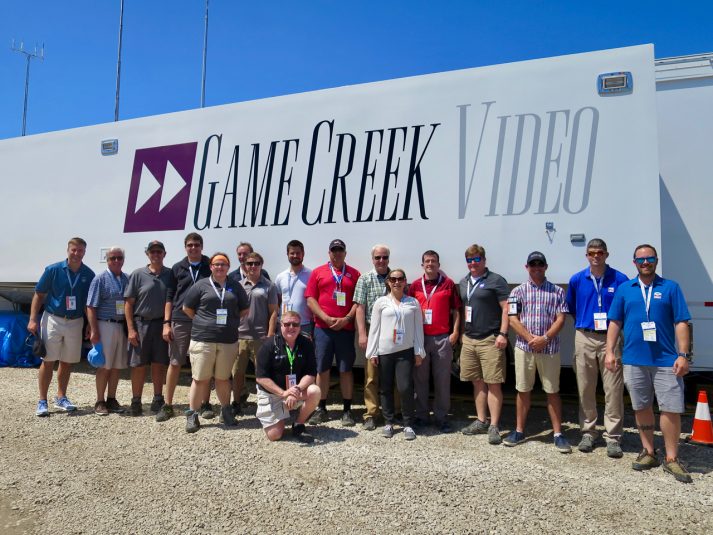
The Game Creek Video crew onsite at Erin Hills.
“They aren’t standalone; they are part of our main production setup,” explained Brad Cheney, VP, field operations and engineering, Fox Sports. “We’re extremely happy with how all of those extra shows have gone. And it’s just proof of what everyone can get done, from producer Mark Loomis and director Steve Beim to the technicians and our vendors.”
Once again, Game Creek Video was onsite in force, with the Encore production unit at the center of the on-course coverage. The only modification from previous lineups was that Maverick replaced Glory for 4K coverage of Holes 13, 14, and 15. Because Maverick had been used by DirecTV at The Masters, rolling it in for the U.S. Open made 4K integration easier because the truck was already set from an engineering standpoint. The HD coverage on those holes relied on Sony HDC-4300 cameras outputting two signals, a 4K and a 720p, via the camera-control unit (CCU).
The core of the production relied on 110 cameras and 216 microphones, including 26 wireless cameras, 31 wired cameras (12 with 100X Canon lenses, 19 with 95X Canon lenses), three Inertia Unlimited X-Mo cameras, and a Sony HDC-4800 operating at 960 fps. Three RF Tracer cameras were also in use. The Towercam, which allows a camera to be raised 18 ft. into the air, was back but in a bigger way: it was now on a Gator tractor from John Deere. A 75-ft. Strada crane and four jib cameras were also onsite. — KK
CLICK HERE for full coverage of the 2017 U.S. Open.
FIFA Confederations Cup Final
St. Petersburg Stadium, St. Petersburg, Russia
July 2
During the FIFA Confederations Cup final between Chile and Germany, the highlights on the pitch were plentiful, but it was behind the scenes where the international broadcasting world eagerly deployed the very latest technology to ensure the best possible TV-viewing experience for football fans around the world.
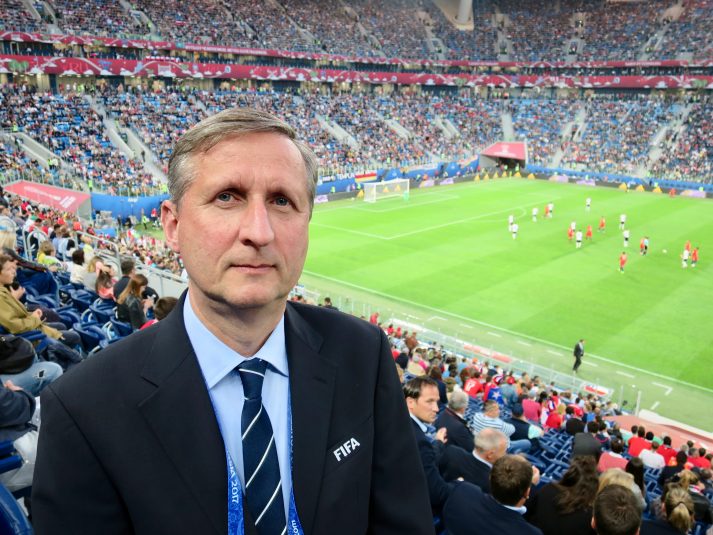
Florin Mitu, Head of Broadcast Production at FIFA
“The tournament was a great success, and, while I know there might be a tendency to think of the FIFA Confederations Cup 2017 as a test event for the FIFA World Cup, it’s actually a huge event in its own right,” said Florin Mitu, head of host-broadcast production, FIFA. “The world was watching, and we had 84 rightsholders, 90 non-rightsholders, more than 2,000 accredited TV representatives, and a host-broadcast staff of more than 800 onsite. These numbers speak for themselves, and it’s without doubt one of our biggest tournament operations.”
The FIFA Confederations Cup took place across four stadiums with the Zenit Arena in St. Petersburg acting as host to the International Broadcast Coordination Center (IBCC) and serving as test bed for the portable cabins, technical infrastructure, and workflows that the FIFA host-broadcast–production team will deploy for each of the 12 stadiums for the 2018 World Cup. ARD/ZDF, Fox Sports, Telemundo, NHK, TV Globo Brazil, Megavision Chile, and DirecTV LATAM were onsite at the IBCC sharing a total space of approximately 900 sq. meters.
The core production of the FIFA Confederations Cup Final made use of five UHD HDR cameras and 15 HD HDR cameras (all using the Slog-3 gamma curve) as well as HD SDR cameras. Moreover, the Sony HDRC-4000 production converter helped convert HD SDR and HD HDR signals into UHD HDR signals, and the FIFA MAX server operated in 1080p mode.
An interesting change in the production of the matches was the decision to replace the HDC-4300 on the Camera 1 position with a Sony PMW-F55 camera equipped with a Cabrio lens from the beginning of the tournament. — KK
MLB All-Star Game
Marlins Park, Miami
July 11
For Fox Sports, the MLB All-Star Game is not only a chance to deploy its proven production tools but also an opportunity to test technologies that are just coming of age. For the 2017 edition, Fox rolled out one of the most robust high-speed–camera complements and on-field–audio setups ever for a baseball game, along with Game Creek Video’s new 4K-capable, IP-router–based Yogi mobile unit.
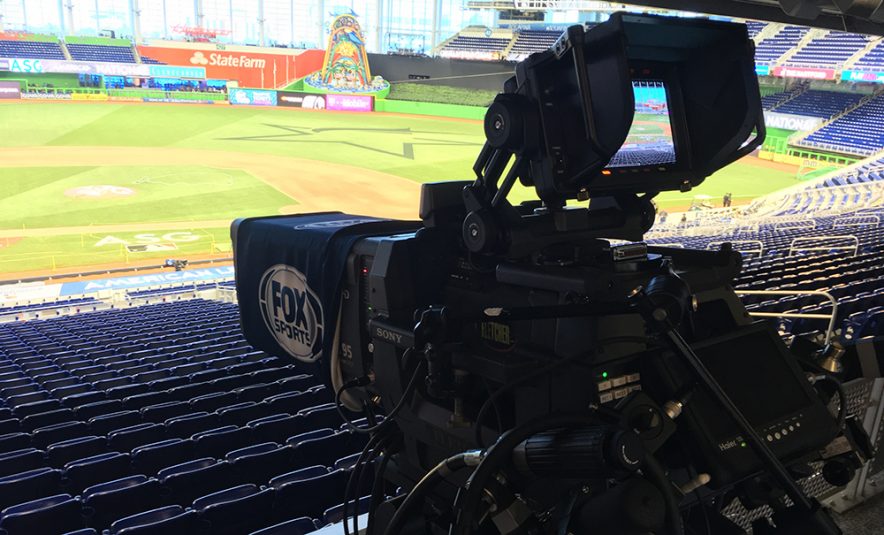
One of two Sony HDC-4800 cameras deployed by Fox in 16X slo-mo mode.
“As always, the All-Star Game brings a chance to try new technologies out and see what sticks for postseason baseball and our other [properties],” said Mike Davies, SVP, technical and field operations, Fox Sports. “And we have amazing and very flexible operations and engineering teams here that can roll with the punches when it comes to [new technology].”
Game Creek’s Yogi 4K production truck (A and B units), launched in March 2017, primarily served Fox Sports’ RSN YES Network during the MLB season.
The cutting-edge 4K-capable mobile unit, which features an IP core, was also deployed for Fox’s All-Star Game and served as the primary truck for its World Series coverage. The powerhouse truck, which can support up to 20 Sony HDC-4300 cameras running in 4K, lends itself to Fox’s high-speed–camera–heavy All-Star plans.
Game Creek Video’s Edit 2 truck served as the C unit for Fox’s All-Star Game production.
In all, Fox Sports deployed eight high-speed–camera systems for the All-Star Game: three Sony HDC-4300’s in 6X slo-mo mode (all in centerfield), two HDC-4800’s shooting at 16X (mid first and mid third), a Fletcher robo with a Sony HDC-P43 POV cam (at mid home), and two Phantoms provided by Inertia Unlimited running at roughly 2,000 fps (at low first and low third). — Jason Dachman
CLICK HERE for full coverage from Miami.
X Games Minneapolis
U.S. Bank Stadium, Minneapolis
July 13 – 16
Over the summer, Downtown Minneapolis came alive with the sounds of revving dirt-bike engines, clapping skateboards, and wailing rock music as the 23rd edition of the Summer X Games descended on the Midwest.
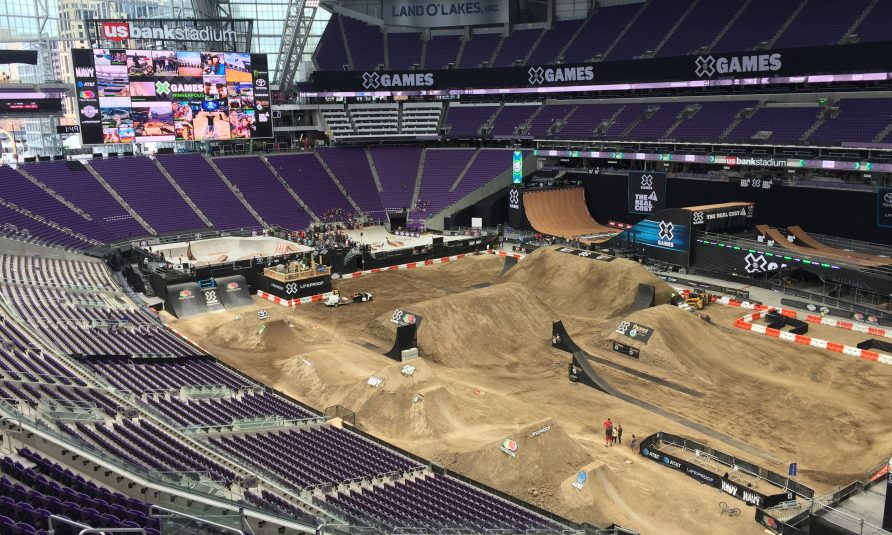
The high-tech U.S. Bank Stadium provided an elite infrastructure from which ESPN and Echo Entertainment could broadcast.
With 18½ hours of linear-television programming and a wall-to-wall social-media and live-streaming plan, ESPN worked alongside new production partner Echo Entertainment to make television magic. The two entities kicked off their relationship at Winter X Games in Aspen in January 2017 and were bullish on the relationship heading into their first Summer X Games together.
“I’ve been in the action-sports world for a long time, and it’s the most collaborative [event] we’ve ever worked on,” said Hugh Arian, president, Echo Entertainment. “It’s great because TV and film is a collaborative industry. It’s been way more [phone] calls than I have even been used to, but, honestly, that’s been great. It enables us to come into the event being on the same page with what we want to accomplish and how we get there.”
ESPN and Echo established 73 camera positions inside (and outside when needed) U.S. Bank Stadium. Of those, 43 were handhelds (many receiving RF support from BSI), 13 were hard, 10 were Sony HDC-4300’s for super-slo-mo capture and playback, seven were POVs, and four were robotics; Spidercam provided aerial shots from inside the stadium bowl.
The high-tech U.S. Bank Stadium — which plays host to the 2018 Summer X Games — provided an elite infrastructure from which ESPN and Echo Entertainment can broadcast.
All resources were connected to an all-Dome Productions compound in the stadium’s indoor truck dock. Dome supplied four A units and a B unit (which played host to the VR production). BSI had an RF-support vehicle, and two satellite trucks provided full satellite transmission to ESPN headquarters in Bristol, CT.
In addition, for the first in the history of the event, ESPN and its partners from Samsung and Digital Domain, offered live productions of select events in virtual reality. Audio was a big part of this VR initiative, including a DiGiCo SD11 console.
— BC
US Open
USTA Billie Jean King National Tennis Center, Flushing Meadows, NY
August 22 – September 10
In the first two years as host broadcaster and sole domestic-rights holder of the US Open, ESPN created a well-oiled machine for its colossal production operation at the NTC. In Year 3 of the 11-year rights deal, with a highly efficient model in full swing, ESPN continued to add to its sizable list of responsibilities onsite while also looking to innovate with Front Row Cam, Silvus Mesh Network, Alteros 6.5-GHz wireless-mic system, Simply Live ViBox all-in-one production system, and other new technologies.
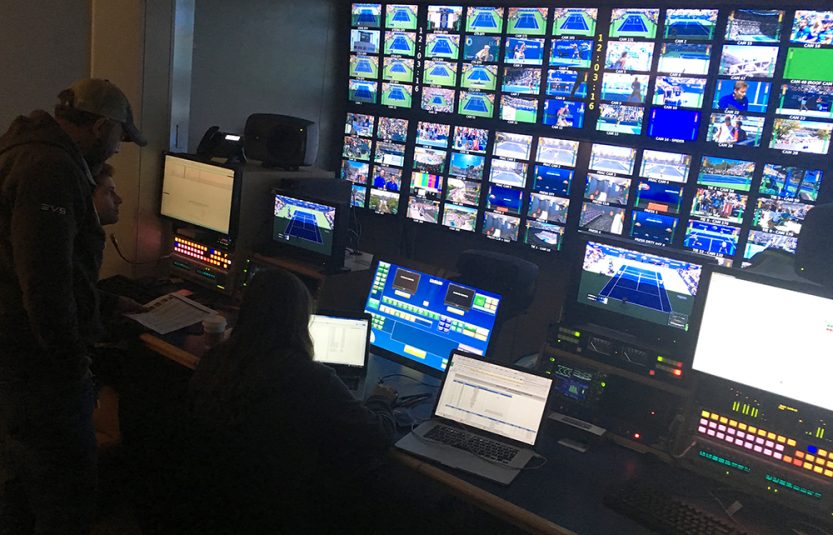
ESPN took over unilateral-content distribution to rightsholders this year.
“Every year is always fresh, but, certainly, being in Year 3 helps tremendously,” said Terry Brady, director of remote operations, ESPN. “I would say, to some extent, [we’ve gotten into a groove], which has allowed us the opportunity to look at some unique technology this year. At the USTA’s request, we’ve also taken on the responsibility of distribution to unilateral broadcasters, which was formerly not handled by ESPN. Every year, we add a little something.’
To support the USTA’s rightsholders onsite, ESPN enlisted Gearhouse Broadcast (which also integrated the NTC Broadcast Center) to create a single core infrastructure, dubbed the Unilateral Distribution Center (UDC). The TOC-style operation takes in 140 feeds from ESPN, distributing them to unilateral broadcasters and to the USTA’s US Open world feed. In addition to Gearhouse, NEP is assisting the USTA with the organization and distribution of feeds. ESPN took over unilateral-content distribution to rightsholders and enlisted Gearhouse Broadcast to construct the UDC.
ESPN’s massive camera complement at the NTC features an exciting newcomer: the telescope-like Front Row Cam, which was used in various court-level positions at the Grandstand, including on the back wall and along the railing next to the line judge.
All the starring camera systems from recent ESPN US Open productions were on hand, including Intel’s 28-camera freeD 360-degree replay system, a SpiderCam aerial system, a RailCam, and an NAC Hi-Motion II ultra-slo-mo at Arthur Ashe Stadium. Also among ESPN’s 100-plus complement of cameras (including 60 broadcast cameras) were a HoistCam, four 3X super-slo-mos, 13 robos, four RF cameras, and five jibs. — JD
CLICK HERE for full coverage from the US Open.
EDITOR’S NOTE: This text was originally published in the 2018 SVG Mobile Production Yearbook.
